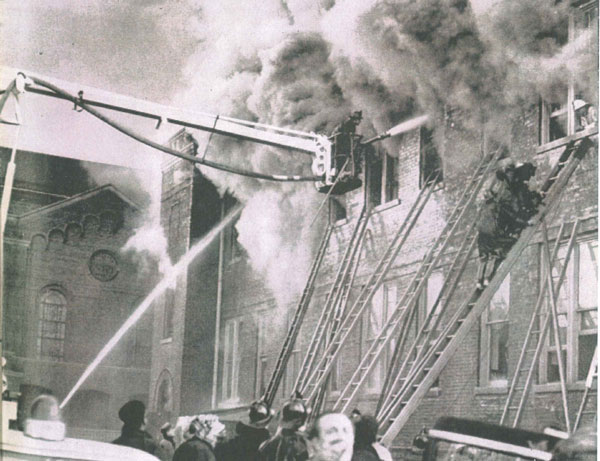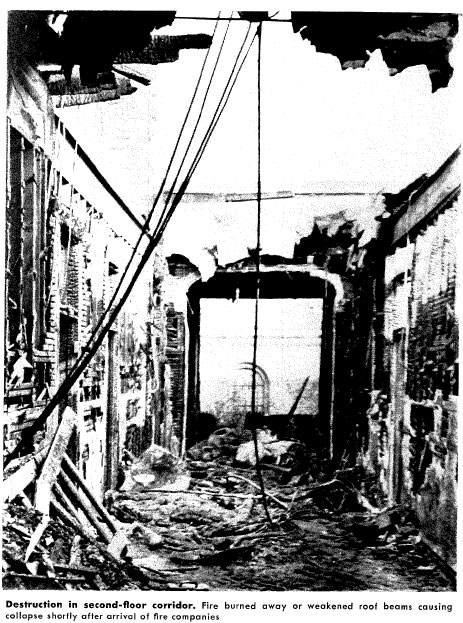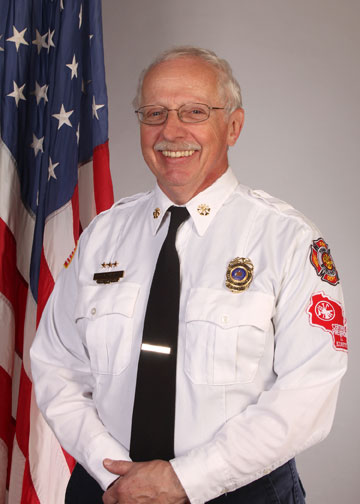
by Gregory Havel
December 1 marks the anniversary of the fire at Our Lady of the Angels Catholic School in Chicago, Illinois. Three of the sisters who taught at the school and 92 children died. Many more were injured by heat, smoke, and jumping from windows to escape the fire, despite the fire department’s efforts in rescue over ground ladders (Photo 1).
The school had about 1,600 students in kindergarten through eighth grade, with about 1,400 in the main school building in grades two through eight. The school was overcrowded, with about 60 students in each of the 24 classrooms.
Several independent investigations were conducted, by the Cook County Coroner, the National Fire Protection Association (NFPA), and Chicago Fire Commissioner Robert J. Quinn.

(2)
Although these reports disagreed on the principal reason for the loss of life (inadequate exits; inadequate fire protection in the building; delayed alarm to the fire department, and its delayed arrival), they agreed on a number of factors contributing to the rapid growth of this fire and its tragic results:
- The construction of the building, with interconnected concealed spaces
- Open and combustible stairways
- Lack of fire-rated partitions and doors between corridors and classrooms
- Glass transoms above the classroom doors (Photo 2 shows the second floor corridor, including two classroom doors with transom frames at arrows)
- Combustible wood trim and combustible interior finishes
- Lack of a working automatic fire sprinkler system
- Lack of a working fire alarm system throughout the building, with a connection to the fire department
- Lack of formal evacuation procedures, and regular fire drills
- Delayed notification of the fire department
- Delayed arrival of the fire department
The recommendations made during these investigations resulted in major changes nationwide in school fire safety regulations; and the life-safety, fire, and building codes were revised and strengthened, and applied to public occupancies in addition to schools.
NFPA 101, Building Exit Code, was extensively revised, based on the school fire and extensive follow-up testing by the Los Angeles (CA) Fire Department. In 1966, NFPA 101 was renamed NFPA 101, Code for Safety to Life from Fire in Buildings and Structures; and was later renamed Life Safety Code. It contains the results of many lessons learned in Our Lady of the Angels School fire (code references are to NFPA 101 Life Safety Code, 2012 edition):
- New educational occupancies are covered by NFPA 101, Chapter 14:
- Automatic fire sprinkler systems are required in any fire area greater than 20,000 square feet (1,858 m2), and in any part of the building below the exit level
- Classrooms and corridors are required to be separated by one-hour-rated walls
- Stairways and other vertical openings are required to be enclosed
- Existing educational occupancies are covered by NFPA 101, Chapter 15:
- Automatic fire sprinkler systems are required in areas below the exit level that are not separated from the rest of the building by fire-resistance-rated assemblies, unless exempted by the authority having jurisdiction.
- Classrooms and corridors are required to be separated by one-half-hour-rated walls
- Stairways and other vertical openings are required to be enclosed if they serve more than two floors
- Means of egress are covered in NFPA 101, Chapter 7
- Occupant Load Factors are covered in NFPA 101, Chapter 7, Table 7.3.1.2
- Automatic fire sprinkler systems are covered in NFPA 101, Chapter 9.7
- Fire alarm systems are covered in NFPA 101, Chapter 9.6
- Manual fire alarm stations are required in both new and existing school buildings at intervals on each floor, and close to each exit (NFPA 101, Chapter 9.6)
- Smoke and heat detectors are required in specific locations
- Interior wall and ceiling finishes are required to have limited flame spread (NFPA 101, Chapter 10.2.3.4)
- Classroom capacities are calculated at 20 square feet (1.858 m2) per occupant, to prevent overcrowding (NFPA 101, Table 7.3.1.2)
- Classrooms with only a single exit are limited to 50 occupants and 1,000 square feet (92.9 m2) (NFPA 101, Chapter 14.2.5.4)
- Maximum travel distance to the exit is limited to 150 feet (45.92 m2) (200 feet (60.96 m2) if the building is sprinklered) (NFPA 101, Chapter 14.2.6.2, 14.2.6.3)
- Waste containers must be noncombustible, with lids (NFPA 101, Chapter 10.3.9)
Although NFPA 101 Life Safety Code is referenced by the model building codes and fire codes, the requirements are not uniform across North America. In many cases the requirements are the decision of the authority having jurisdiction. The Life Safety Code and model building and fire codes are not binding unless adopted by the federal, State, or municipal government.
For more information on this tragic fire, visit the Web site http://www.olafire.com The Web pages have building plans and three-dimensional models, photographs, national news stories about the fire; and statistics about the building, its occupants, and the fire’s victims.
Also, search the Learning Resource Center’s online catalog at the National Fire Academy at http://www.lrc.fema.gov/index.html ; and search the Internet for “Our Lady of the Angels Fire”.
Download this article as a PDF HERE.
Read a retrospective on the fire from the August 1977 issue of Fire Engineering HERE (3 MB), and read part 1 of this article HERE.

Gregory Havel is a member of the Town of Burlington (WI) Fire Department; retired deputy chief and training officer; and a 30-year veteran of the fire service. He is a Wisconsin-certified fire instructor II, fire officer II, and fire inspector; an adjunct instructor in fire service programs at Gateway Technical College; and safety director for Scherrer Construction Co., Inc. Havel has a bachelor’s degree from St. Norbert College; has more than 30 years of experience in facilities management and building construction; and has presented classes at FDIC.

